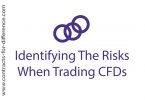Investors are attracted to CFDs because of the leveraged opportunities they offer, the low initial capital required to commence trading and the perceived ease of trading. However, most investors are oblivious to the risks of CFDs and lack a real understanding about the impact of leveraging and how it can devastate them and this misunderstanding is at the centre of CFD risk.
It’s a pity, but some people are attracted by exaggerated claims of the fortunes that can be made trading contracts for difference, and never learn how to use their accounts safely before they lose all their money. These are the friends who tell you that, overall, they just break even or are just slightly profitable over time. While many see large returns on individual trades, these are counterbalanced by losses on others and CFDs are unlikely to meet the investment needs and objectives of all retail investors.
CFDs can be defined as high-risk derivative instruments typically used by sophisticated traders to take geared, short-term positions in volatile markets. Leverage is the one big attraction, and risk, of trading contracts for differences. Trading shares on margin via CFDs requires less cash than the equivalent share purchase, but you are still exposed to the same absolute profit and loss. Many investors will tell you that trading a derivative like a contract or difference is risky and for the most part they are right. You only have to deposit a fraction of the value of the shares, forex or commodities that you buy. If you buy a share CFD, putting up 10 per cent of the value, you make a 100 per cent profit if the shares go up just 10 per cent. Similarly, if the shares fell 10 per cent, you would lose your whole starting amount. That’s 10 times the gain or loss compared with purchasing the stocks themselves. What most people miss is that you control the gearing or leverage which implies that you have control on the risk.
Education: The Power of Leverage
The capacity to make a gain from small percentage moves on a share, forex pair or index is because of one important thing; the power of leverage. The leverage level offered by the CFD broker magnifies the underlying movement of the share, which can be both positive and negative.
A key benefit of CFDs is the ability to trade securities on margin i.e. ability to gain exposure to a share, index or currency contract with a relativel small capital outlay. As opposed to having to pay for the full notional value of the CFD contract, investors can enter into positions with margins as low as 5 to 10%. This gives CFD traders a greater exposure than can be achieved by trading traditional, non-leveraged securities. However, it is important to note that even though a smaller initial deposit is needed to open the trade, you are still exposed to the price movement of the share CFD for the full notional worth of the position. In other words, despite a smaller commitment of capital, the CFD trader still acquires exposure to the impact of price swings for and against the full face-value of the trade.
Trading a CFD at 10% margin is equivalent to leveraging your exposure by 10 times, so a $10,000 deposit might allow you to open positions for up to $100,000. This in turn means that small fluctuations in price might result in much larger gains but this also works in reverse – losses can also be magnified if the price moves against your position. For instance when trading a CFD with a margin of 5%, a price rise of 2% of the underlying asset may result in gains of 20% – but if the price fell by 2%, this might lead to a loss of 20% of the amount you deposited to open the position.
First and most obvious it is important to gain an exhaustive understanding of all the facets of CFDs and the leverage effect they can offer via the margin feature – which cuts both ways; leveraging your trading capital in this way can either work for you or against you. The concept of leverage, or gearing, of your account is one that many people find difficult to understand, but it is essential to become educated before committing real funds. CFDs are essentially a leveraged bet on future changes in the market price.
Many CFD traders look only at the extra buying power that leverage makes available to them. They make the mistake of ignoring the fact that leverage is a double-edged sword. Why on earth would anyone want to trade financial products that could potentially wipe you out? Here is a naive perspective of a common investor without an understanding of leverage mechanics looking at this:
If Dave invested $10,000 of his savings into the stock market by buying shares and it went up 10% he’d make $1,000. Big deal. If Dave on the other hand put in $10,000 of his savings into CFDs and it went up 10% he’d make $10,000. Big deal!!
Leverage Effect
Perhaps the most familiar comparison that can be drawn is with buying a house with a mortgage. Most people understand that they can buy a house by putting 10% or 20% down, and borrowing the rest of the money on a mortgage which they pay back over a period of years. Until the housing bubbles of recent years, this has been considered an extremely safe and profitable way of using your money. You could buy a house worth $200,000 by paying only $20,000 as a deposit and making payments of $1000 per month. When the value of the house rose by 10%, you “made” $20,000 on your initial investment of $20,000.
The housing bubble represents what can happen when you trade CFDs. Leverage is a good thing if you are making good trades, but a terrible thing if you trade badly and do not know about money management. Newcomers to CFD trading sometimes took the same view as buyers of real estate used to, and believed that prices would never go down. As prices go down, and as CFDs go down, you can end up owing more than you have available. With houses, it’s known as being underwater, or upside down on your mortgage, and with CFDs you get wiped out.
That’s the simplest way to understand how leverage can work against you as well as for you. With houses, it was sometimes difficult to find a buyer as the value fell, and in any case people needed somewhere to live and didn’t want to sell. With CFDs, how much you lose is under your control, because in a losing position you can choose the moment that you sell. If you wish to keep your risk to a bare minimum you can trade CFDs with no leverage and treat your account like a share dealing account. So with $20,000 cash in your trading account, you would take positions not exceeding $20,000.
Because of the way leverage works, CFD traders need fully to understand the risks and costs involved. Gains and losses are based on the full contract value once the trade is closed. This means that on the positive side, profits can be significantly greater than the initial deposit outlay required to setup the trade. On the negative side, the loss can also be considerably larger than the original cash outlaid when entering the trade.
In practice there are two things that govern and control your losses. One is the price, less than your entry price that you decide will tell you your trading idea didn’t work. The other is the amount that you put into the trade. By looking at the two of these together, you can see how much money you could lose. To trade safely, you should set a limit that you are prepared to lose on a trade, and many traders set this at 2%. You can then work backwards to see what the most is that you should put in a particular trade.
If you aren’t comfortable with the level of leverage you are utilising on a trade, then simply cut back. Some CFD providers like IG Markets offer mini contracts on certain markets, so if you feel anxious about what effect the movement of one point against your position will have on your running profit or loss, then you an simply cut back the size of the trade. As David Jones of IG Markets puts it ‘It is difficult enough to get market direction right without getting stressed by every small move in the market’.
There is nothing wrong with CFDs – the problem is with the way investors use them. For such a turbocharged product you really need to know what you are doing but instead some people are clicking past all those terms and conditions without reading a word – Marcus Padley, Patersons Securities






